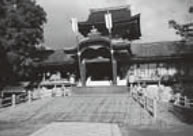 「寺社を歩けば京都がわかる」 より無料公開中!
「寺社を歩けば京都がわかる」 より無料公開中!
精選した京都の50余の寺社について、その歴史、建物の特徴、建立の由来などを日英対訳で紹介するガイドブック「寺社を歩けば京都がわかる」より、「龍安寺」「石清水八幡宮」「天龍寺」を無料公開中です。
A mountaintop shrine bespeaks the devotion of a warrior clan
 Address: 30 Yawata Takabõ, Yawata-shi
Address: 30 Yawata Takabõ, Yawata-shi
Tel: 075(981)3001
Hours: 5:30AM–6:30PM (May vary depending on season)
Admission: Free
http://www.iwashimizu.or.jp/
7 min walk from Otokoyama Cable Line Otokoyama-sanjõ Sta.
from Keihan Line Yawatashi Sta.
From the peak of Mt. Otokoyama (142.5 meters) where Iwashimizu Hachiman-gū is situated, one can look down on the Yodo River where the Kizu River, the Uji River, and the Katsura River converge on Mt. Tennōzan to the west, and on the roads and rivers that run between the mountains below. From old times, it was highly valued as a place to parley with western countries and a location of strategic value.
The shrine was built on top of Mt. Otokoyama in 859. The legend goes that a priest named Gyōkyõ, of Daian-ji, one of the seven great temples in Nara, came on a pilgrimage to Usa Hachiman, and on the last night of his stay, he received a vision from the god of Hachiman saying, “Worship me in the capital.” The priest carried this message to Emperor Seiwa (r. 858–76), and he was ordered to build a shrine in response.
The shrine’s name ‘Iwashimizu,’ which means water that flows between rocks, came from the Iwashimizu-dera that had stood on Mt. Otokoyama. The temple's name was changed to Yūtokusan Gokoku-ji, and it was made into a temple that guards a Shinto oracle. The temple was responsible for the affairs of the shrine until the separation of Shinto and Buddhism in the Meiji era.
The most convenient station from which to visit the shrine is Yawatashi Station on the Keihan Dentetsu Honsen line, two stops from Chūshojima Station. In the past one had to climb a long, steep, stone staircase, but the Mt. Otokoyama cable car has now opened from the train station up to near the hon-den 80 meters above, making the visit much more convenient.
At the New Year Yakuyoke Taisai Festival (a festival to ward off misfortune), two massive arrows are raised high above the two-story gate, reminding us that this shrine proved the devotion of a warrior clan. After Minamoto-no-Yorinobu and his son Yoriyoshi sought success in battle at this shrine, the whole clan pledged their devotion, and Yoriyoshi's oldest son Minamoto-no- Yoshiie performed a ceremony for attaining manhood here, taking the name Hachiman Tarõ. Later Minamoto-no-Yoritomo and the Ashikaga shoguns sometimes came here for worship, and when the buildings were destroyed by war or fire, Oda Nobunaga and Toyotomi Hideyoshi had it rebuilt. Tokugawa Ieyasu also bestowed a large amount of land for building the shrine, and in 1634, the third shogun Iemitsu built the hon-den, the gai-den, the two-story gate, mai-dono and other grand buildings that we see today.
The 180-meter-long corridor encircles the main buildings at the top of the stone stairs. Behind the hon-den are several subshrines, serenely appropriate to the shrine environs. At the southwest side of the grounds stands the Edison Memorial, commemorating Thomas Edison’s use of bamboo from Iwashimizu Hachiman-gu for the filament of his incandescent light bulb, invented in 1879.